
arcadia
Video Valhalla
SEE! SEE!
THE WORST FLOPS! THE DUMBEST GAMES! ENTIRE COMPANIES CRUMBLE AND FOLD! ARCADE MACHINES THAT WILL MAKE YOU CRINGE IN EMBARASSMENT AND DISGUST!
No more Mister Nice Guy. For eleven issues now, I’ve tried to present an intelligent, mature examination of the arcade experience—taking into consideration economic and sociological factors affecting the sort of machines we’re playing. I’ve revealed how they’re designed, enhanced, and manufactured. I’ve been temperate, sober, and solicitous.
Well, forget the old me. Here I present the amusement parlor pit; the worst hunks of garbage the companies ever foisted in the name of cash flow. Ah, but before the claws are fully extended, let’s just say that no company goes out of its way to make a pitiful videogame. It is usually lack of experience, bad luck, or woefully wrong-headed thinking that rings the death knell for arcade machines.
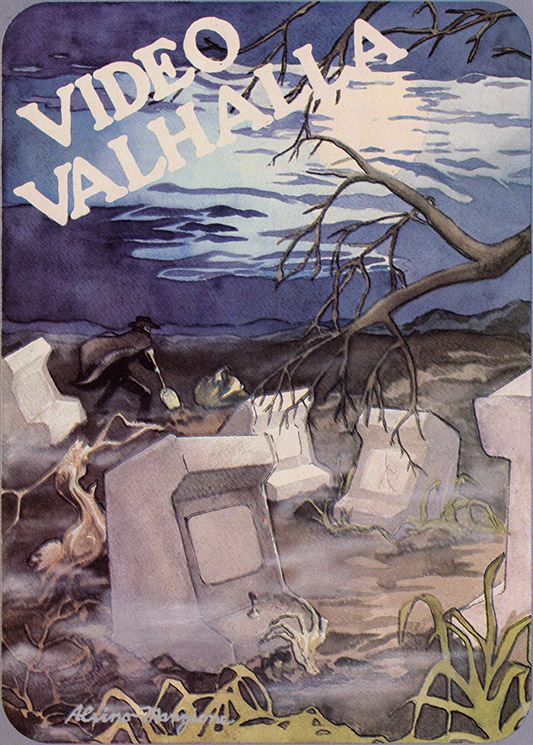
That disclaimer taken care of, it’s time to get our eyes dirty. In alphabetical order, the first manufacturer to come under fire must be Atari. Verily, the makers of such greats as Star Wars have produced some noxious specimens, all right, starting with the infamous pinball machines of 1978.
Just as the company was getting its wind up, they made the mistake of releasing four pinball machines that were devilishly clever, sumptuously designed, and about as dependable as a fourteen year old Pinto station wagon. No sooner did they settle into the arcade than they started breaking down.
Time 2000 was a four flipper machine with a fantasy motif, Space Riders was a wide body game with a “Road Warrior” look, Middle Earth had an upper and lower playing field each with its own pair of flippers, and Airborne Avenger had a superhero formula. Their Superman pinball game fared better, but was almost as mechanically unsound.
Atari downplays the existence of these fiascos, even though they were neat experiences for those few who were able to play them before they broke down. There is nothing quite as bad as a bad mechanical reputation in the game industry. No arcade operator will shell out five big ones for a game they can’t use and can’t fix.
ATARI’S ACHES
However, what Atari can’t keep quiet was the resounding thud their videogames made, starting with the odious Asteroids Deluxe in 1981. This was a frightening circumstance, coming on the heels of their spectacularly successful Asteroids Regular. With the latter game, Atari had hit its stride, putting out Missile Command in the meantime. Suddenly the bottom fell out.
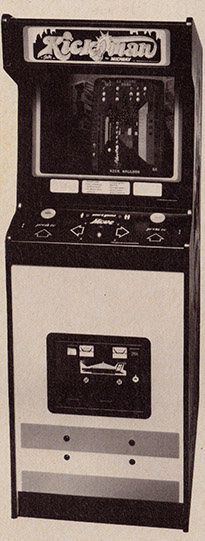
On face value, the Deluxe model was a valid toughening of the original. But during actual gameplay, the buttons were difficult to dance on and the recessed playscreen was confusing to watch—especially in the dark environs of a bar, restaurant, or shopping mall arcade. People started turning away in disgust from that, and all of Atari’s other new releases.
First there was Battlezone, the cult favorite. Although fascinating from many standpoints, what wasn’t fun at all was the machine’s tendency to “fade out.” Suddenly the green-outlined enemy targets were impossible to see, creating an invisible adversary. Coming quick on its heels was Red Baron, another wargame that depended upon a screen picturing green-outlined enemies—in this case, World War One-vintage aircraft.
The worst, however, was Warlords, a dippy divertisement that placed the player above two knights in outlined armor, one of which the player controlled. Avoiding bottomless pits, the player must have his man hack the other man before he becomes the hackee. The game was slow-moving and awkward enough without having to wrestle with the controls that often led to digitalized dismemberment.
Finally, however, Atari was saved by a few successes that rescued the company from the red. Centipede, tempest, Space Duel, and Dig Dug put them on a winning roll until their ugly attempt to cash in on Donkey Kong in 1982. Yes, it’s Kangaroo. All right, everybody who really likes that game raise their hands. I mean, really, hop up steps, ring bells, collect fruit and punch monkeys. Brilliant.
Actually, about as brilliant as Black Widow, the spun web game of spitting spiders, egg-laying bugs, and fly squadrons. To play it is to experience the perpetual yawns. At least it’s better than Cinematronics’ Battling Bugs—a similar videogame where a star-spurting boxing glove bops bomb-dropping insects. With games like that, it’s no wonder the company was in bankruptcy just before distributing the laserdisc Dragon’s Lair game.
BALLEY’S BOMBS
Next on the alphabetical hit list comes Bally/Midway, the company that communicated Pac-Man fever. But before that disease, the company was responsible for the pinball plague. There was hardly a one that could be considered poor before the advent of videogames, but the company became so desperate to compete with the burgeoning video market in 1980 that several oddities were spawned.
There was the loud, obnoxious Groundshaker, a machine with a stock car motif. That was the game voted “Most Likely to Drain the Ball.” Among pinball players, it is considered one of the most irritating. Between the blasting race car sound effects and the poor play angles, Groundshaker was no earthshaker.
The game considered to be the most disappointing was Fireball II, the inferior sequel to the hugely successful original Fireball. Thankfully, pinball makers have learned what Hollywood hasn’t—the remaking of an unimprovable classic leads to failure. Recently, the companies have wisely chosen to update less than perfect oldies (but goodies).
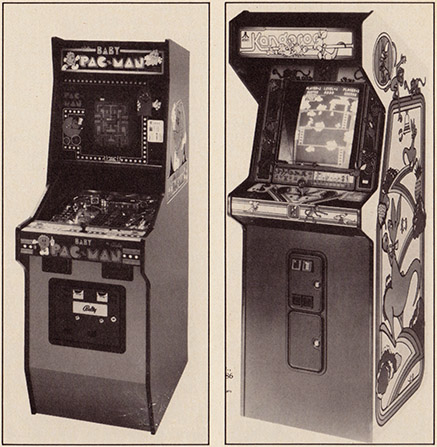
Bally/Midway has an enviable record of successes, but their flops are wondrous to behold. In retrospect, they should have known better than to go “spin-off crazy,” but also in retrospect, it seems that their spin-offs were hits more than misses. One excruciating exception was Kick-Man, generally considered by many arcade owners as the worst Bally money maker ever.
As originally conceived, Kick-Man was supposed to take care of the kiddies; those too young to play Pac-Man, Ms. Pac-Man, Super Pac-Man, Pac-Man Plus, Mr. and Mrs. Pac-Man Pinball, and Baby Pac-Man. But who’s too young to play those things? Somehow, somebody thought that watching a tricycle-riding clown fall on his kiester every time he misses catching, kicking or popping a balloon on his hat would mean millions in the Midway mint.
No chance. Kick-Man fell on its tuchus in every location. The same went for Solar Fox, the companion videogame released the same month as the best selling Tron. The former game was a redundant, easy, and ultimately dull variation on all the maze games that preceeded. Watching an adolescent wrack up millions of points on his/her first try and play for a half-hour on one quarter did not warm profit-minded arcade owner’s cockles.
MID-LIFE CRISES
Even so, Midway had little on D. Gottlieb and Company, a usually dependable bunch which made the bad mistake of following Bally’s lead in the pinball tie-in department.
Being owned by Columbia Pictures, they got the go-ahead to spin-off a lot of the corporation’s television and movie products. Sadly, their gameplay vision did not match that of the original concept in several cases, most particularly that of the Close Encounters of The Third Kind pinball machine.
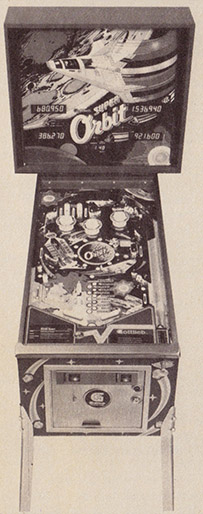
Now here was a concept rife with possibilities, none of which Gottlieb seized—opting for a plain, lifeless game with the UFO motif merely painted on. The same was true of their Charlie’s Angels game, which could have been any pinball machine for all it related to female detectives. Most great designers try to tie in the game play with the theme. Not so here. Thankfully their Sinbad, Spider-Man, Hulk, and Buck Rogers machines were better.
An unfortunate failure was the James Bond pinball machine, a natural concept if there ever was one. Although wide-bodied and containing a time-ball feature that kept the ball in play longer, the design was surprisingly sparse and drab, resulting in uninspiring play. And any good player knows that no matter what the theme, the game has to be good if it is to succeed.
Gottlieb was more cautious when entering the videogame market and failed to hit paydirt until 1983. Prior to that came three failures: No Man’s Land in 1980, New York, New York in 1981, and Reactor in 1982. All were pretty poor—the latter getting a case of Solar Fox fever, the disease that makes gameplay all to easy once the hang of it is acquired.
Nichibutsu is next, the Japanese company with the owl logo. Although doing all right with a series of videogames with “Moon” in their names (Moon Raker, Moon Cresta, Moon Alien, and Moon Shuttle), they blew it with Crazy Climber. Initially appearing to be a good game, the hapless player only discovers the infuriating controls after spending his or her hard-earned coin, Simply spoken, Crazy Climber’s controls never worked right.
It was tough enough climbing from skyscraper window to highrise window with flower pots and eggs falling, but being unable to avoid the pitfalls because the controls would not respond was especially frustrating. Equally as frustrating was many of Sega/Gremlin’s machines. It’s all fine and dandy that Zaxxon’s a winner, but how about 005 and the ever-lovely Tranquilizer Gun?
The former title is a spy game that is as boring as it is confusing. The latter is another Sega mystery, equal to that of Samurai, a nifty game that was practically yanked out of the arcades right under eager player’s fingers. The Gun game had the player knocking out wild beasts while the Japanese Warrior game faced the player against sword carrying opponents and ninja within an oriental garden. What happened to these games? Only Sega knows for sure and so far, they’re not talking.
LOW LEVEL RADIATION
Stern is less hapless than Sega, spotlighting only one misstep along their way. That was Orbiter 1, a promising pinball concept that players and distributors made lie. Remember, that was the game with spinning bumpers and a moon-like cratered surface instead of the customary pinball bumpers and sloped playfield. The jerking, uneven gameplay just didn’t light patrons’ or promoters’ fires.
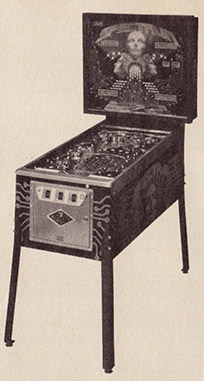
Up until now, the article has been picking on the big boys—the major manufacturers who have put out mostly magnificent machines. It would be hardly fair to omit the laughable hack artists who try to sneak all too transparent rip-offs into the marketplace—things like Crazy Kong, Puck-Man and the like. While the following few folk are not in that low, illegal league, they are in the underdog position—trying to make gravy from one or two machines.
There’s Tago’s Anteater, a quirky, ridiculous game with the title animal’s tongue slopping up underground dots, ants, and worms before the spiders come out at sunset. Then there’s Thomas’ Triple Punch, with a Mario-like man making Pepper II-like squares across a board while avoiding fire, ghosts, and apes.
These cheap, unpromoted machines pop up from time to time, but are usually quickly squeezed out by the major’s releases. Still, one or two mid-size companies manage to put out clinkers to rival those of their big brothers. Taito, for instance, makers of Qix, also released Wild Western, an old-fashioned shoot-out game with confusing controls and all too unreliable features. Universal, the distributors of Lady Bug, in the meantime, missed with Snap Jack, a vehicle riding over rough terrain game.
Its failure mirrored that of Moon Patrol, Williams’ seemingly can’t-miss machine that proved fruitless for most players. The moderate mess it made can’t compare with Hyperball, the company’s pinball mutation that wanted to start a fad, but wound up laying eggs. Basically a silver ball shooter, Bally jumped the gun by releasing Rapid Fire at the same time. Both died dismal deaths in the market place, as did each company’s subsequent attempts at pinball evolution; Spectrum (Bally) and Thunderball (Williams).
Both of those replaced the launching plunger with an automatic shooter and both cleared the playfield of most traditional targets. Instead there were patterns to be hit and tunnels to be investigated. In other words, both games hoped to mesh pinball play with video thrills. Both failed.
A SUITABLE CAUSE FOR TREATMENT
There you have it, then. The critical machete is returned to its sheath and the companies can sleep securely, knowing that the Arcadia section will now return to its previous purpose of illuminating the world of the amusement center and the manufacturers who supply them.
That purpose has certainly been well served here, of course. What could be more illuminating than having your every mistake and misstep pointed out by one with all the benefits of hindsight and professional near-ignorance?
Even so, be assured that this vitriolic jaunt has been a sincere and, we hope, worthwhile endeavor in uncovering harried attempts to maintain the status quo in a business that can only prosper by invention and imagination.
Source Pages





